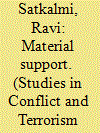|
|
|
Sort Order |
|
|
|
Items / Page
|
|
|
|
|
|
|
| Srl | Item |
| 1 |
ID:
061576


|
|
|
|
|
| Publication |
May-Jun 2005.
|
| Summary/Abstract |
This article provides a descriptive, operational analysis of the modern anarchist movement, emphasizing the actions of the criminal anarchists and implications for US law enforcement. It begins by explaining some core tenets of anarchist “theory,” and its relationship to violence, then describes the structure, tactics and tradecraft of militant anarchist activists. It concludes that Anarchism is a revolutionary movement, not just a “protest group.” Clearly not all anarchists advocate or engage in violence, but some do. Those individuals and factions pose a particular concern to law enforcement. This article offers some practical recommendations to law enforcement for preventing and managing those direct action attacks that may compromise public safety.
|
|
|
|
|
|
|
|
|
|
|
|
|
|
|
|
| 2 |
ID:
061578


|
|
|
|
|
| Publication |
May-Jun 2005.
|
| Summary/Abstract |
This article argues that the breakdown of hierarchical structures in illicit organizations is creating new opportunities for criminals and terrorists to collaborate. The rise of networked organizations has given greater independence to criminals and terrorists who previously answered to a clear chain of command. These members are now willing to engage in operations that before had been off-limits because the leadership believed the activity would hurt the organization's broader mandate. The result is that a “leaderless nexus” is beginning to emerge between criminals and terrorists. The phenomenon has far-reaching and dangerous implications for U.S. security, and should be thoughtfully considered as lawmakers debate homeland security reform.
|
|
|
|
|
|
|
|
|
|
|
|
|
|
|
|
| 3 |
ID:
061579


|
|
|
|
|
| Publication |
May-Jun 2005.
|
| Summary/Abstract |
The pre–11 September intelligence era challenged the security community to acquire actionable intelligence about the impending terrorist attack. But what is actionable intelligence? This article argues that it is an awareness of the target, timing, and type of attack being planned, and presents evidence that at least one of these elements was missing from the threat signals provided by the National Security Agency, Rick Rescorla, Nawaf al-Hazmi and Khalid al-Mihdhar, Zacarias Moussaoui, and Kenneth Williams. Thus, the 2001 attack could not have been prevented.
|
|
|
|
|
|
|
|
|
|
|
|
|
|
|
|
| 4 |
ID:
061574


|
|
|
|
|
| Publication |
May-Jun 2005.
|
| Summary/Abstract |
The presence of radical Islamic networks in Spain can be traced back a decade prior to the attacks on Madrid in March 2004. This article intends to offer a panoramic view of the different groups that compose the Jihadist map in Spain. The activities, general profile of the members, and major structural characteristics of these networks are described. Ultimately, factors that could influence the future evolution of this phenomenon are outlined.
|
|
|
|
|
|
|
|
|
|
|
|
|
|
|
|
| 5 |
ID:
061575


|
|
|
|
|
| Publication |
May-Jun 2005.
|
| Summary/Abstract |
In December 2003, six American-Yemenis were sentenced for terms of seven to ten years for their role in providing material support to Al Qaeda, in violation of Title 18 United States Code §2339B. This article specifically examines the merits of the charge brought against the Six by reviewing precedent that has developed regarding §2339B from 2000 to 2004. This exercise uncovers a controversy over constitutionality, basic rights and due process that, in combination with the facts of the case, could have yielded each of the Six a better deal were the case to go to trial than he received by pleading guilty. Those pleas, made under real pressure from the prosecution, prevented the court from determining whether the Six “had ‘provided’ support to Al Qaeda, or merely ‘received’ it.”
|
|
|
|
|
|
|
|
|
|
|
|
|
|
|
|
| 6 |
ID:
061577


|
|
|
|
|
| Publication |
May-Jun 2005.
|
| Summary/Abstract |
An analysis of three years of suicide bombing data in Israel reveals an increase in such attacks through March 2002 followed by a steep decline through the end of 2003. The authors propose a terror-stock model that treats the suicide bombing attack rate as a function of the number of terrorists available to plan and execute suicide bombings. The intent of Israeli tactics such as targeted killings and preemptive arrests is to reduce the capacity of terror organizations to commit attacks. When fit to the data, this model suggests that the targeted killing of terror suspects sparks estimated recruitment to the terror stock that increases rather than decreases the rate of suicide bombings. Surprisingly, only the deaths of suspected terrorists, and not Palestinian civilians, are associated with such estimated recruitment. Although Israeli actions have reduced the rate of suicide bombings over time, it is preventive arrests rather than targeted killings that seem more responsible for this outcome.
|
|
|
|
|
|
|
|
|
|
|
|
|
|
|
|
|
|
|
|
|